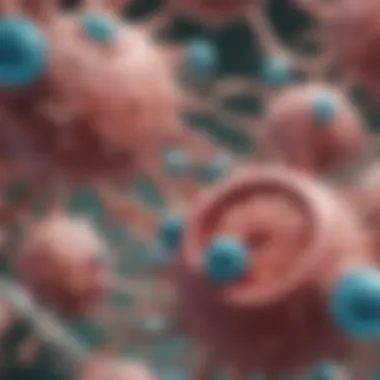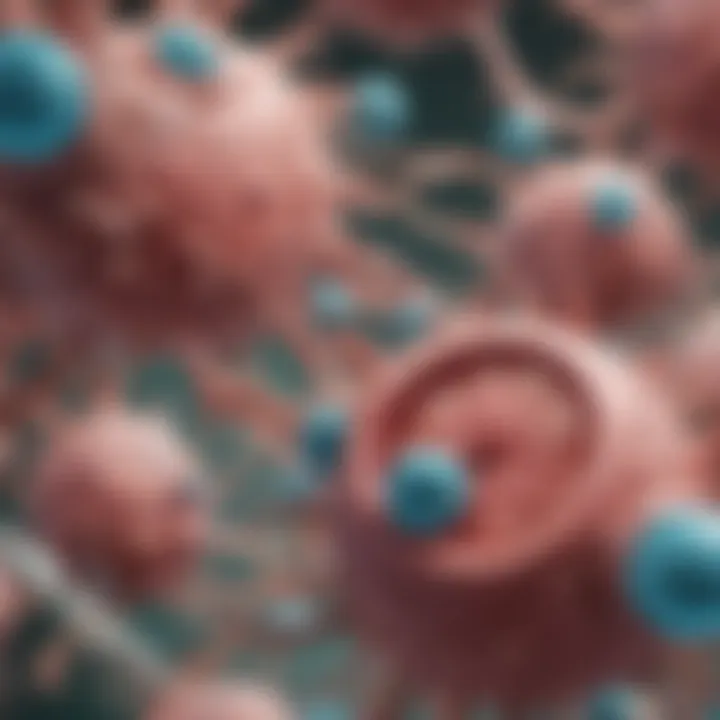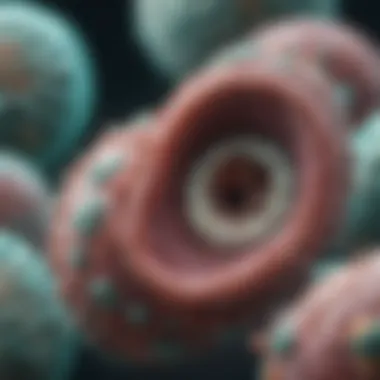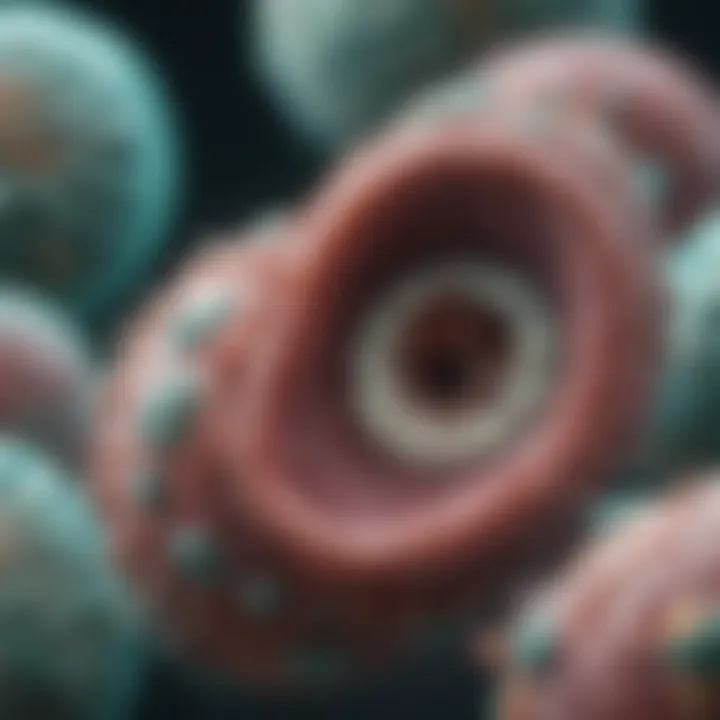Understanding Ovarian Fibrosis Cysts: Implications and Insights


Intro
The understanding of ovarian fibrosis cysts encapsulates a web of biological intricacies intertwined with clinical implications for women's health. These cysts, often misunderstood, are not merely benign tumors but represent a spectrum of conditions that can influence fertility and overall reproductive health. As a focal point in gynecology, grappling with the nuances of ovarian fibrosis cysts is essential for both healthcare practitioners and patients. In the following sections, we'll delve into the critical concepts and terminology related to this subject, unpacking the findings and discussions that underscore their importance.
Key Concepts and Terminology
Definition of Key Terms
In embarking on this exploration, clarity in terminology is crucial. Ovarian fibrosis cysts are fluid-filled sacs that form on or within the ovaries and can vary in size and shape. Common terms related to this topic include:
- Fibrosis: A thickening and scarring of connective tissue, often caused by injury or inflammation.
- Cyst: A closed sac-like structure that contains fluid, air, or other materials.
- Benign: A term used to describe conditions that are not cancerous and typically do not spread to other parts of the body.
- Malignant: Refers to cancerous tumors that grow uncontrollably and can invade other tissues.
Concepts Explored in the Article
This article aims to provide an in-depth look at several interconnected concepts:
- Pathology of Ovarian Cysts: Understanding how and why these cysts form.
- Diagnosis: Methods used to identify ovarian fibrosis cysts and differentiate them from other forms.
- Treatment Options: An overview of current therapies, how they work, and their efficacy.
- Impact on Reproductive Health: Analyzing how the presence of these cysts can affect fertility and pregnancy.
- Long-term Considerations: Looking at what patients may face in terms of ongoing management and health outcomes.
Findings and Discussion
Main Findings
Through a review of current literature and expert interviews, several key findings emerge:
- The distinction between benign and malignant cysts is often nuanced and requires extensive diagnostic testing, including imaging and sometimes surgical intervention.
- Treatment options vary widely, from watchful waiting in benign cases to more aggressive measures such as laparoscopic surgery for complex cysts.
- Studies indicate that many women with ovarian fibrosis cysts may remain asymptomatic, leading to potential delays in diagnosis.
Potential Areas for Future Research
Future exploration in this realm could focus on:
- The genetic basis of cyst formation, particularly in women with a family history of ovarian disorders.
- Longitudinal studies to track the outcomes of treatment across diverse populations, providing insight into treatment efficacy and safety.
- Investigating the psychosocial implications for women diagnosed with ovarian fibrosis cysts, enhancing patient care and support mechanisms.
The complexity surrounding ovarian fibrosis cysts necessitates a multi-disciplinary approach, combining clinical expertise, patient-centered care, and ongoing research.
In synthesizing these discussions, we gain a comprehensive understanding of ovarian fibrosis cysts. Close examination of these factors not only paves the way for improved therapeutic strategies but also enhances the dialogue within the healthcare community on effective management practices.
Prelims to Ovarian Fibrosis Cysts
Ovarian fibrosis cysts present a complex landscape in gynecological health, drawing the attention of both medical practitioners and researchers alike. Understanding these cysts is crucial, not just for academic purposes but also for the real-world implications they hold for women. Ovarian fibrosis cysts, while often benign, can affect reproductive health in significant ways and contribute to a range of symptoms that warrant thorough investigation.
These cysts originate from the ovarian follicles and can be accompanied by varying degrees of fibrosis, a thickening and scarring of the ovarian tissue. To put it succinctly, ovarian cysts can create a domino effect on fertility, hormonal balance, and overall wellbeing. For anyone concerned with women's health, grasping the details surrounding these cysts is imperative.
- Relevance of Cysts: The presence of ovarian cysts often indicates underlying health issues that can range from hormonal imbalances to more serious conditions that necessitate urgent care.
- Impact on Fertility: Many women face challenges related to fertility due to these cysts, which may lead to difficulty in conception or complications during pregnancy.
- Diagnosis and Treatment: A solid understanding of how to diagnose and manage these cysts can vastly improve patient outcomes. Cysts can sometimes be asymptomatic, but awareness of potential signs is vital for early intervention.
In the following sections, we will dissect the anatomy and pathology of ovarian fibrosis cysts and delve into their etiology, offering a broad perspective on their implications within the context of women's reproductive health.
Defining Ovarian Fibrosis
Ovarian fibrosis refers to the formation of fibrous tissue in the ovaries, often as a response to chronic inflammation, injury, or hormonal changes. These cysts arise from the ovaries' need to heal and adapt to various stressors. Fibrosis can lead to structural changes within the ovarian architecture, which can ultimately affect function.
Fibrous tissue can hinder the normal histological structure, which might create challenges for the follicles to mature properly. This leads to a whole host of complications, including hormonal imbalances and altered menstrual cycles. Recognizing this process is pivotal to diagnosing and treating related infertility problems.
Etiology of Ovarian Cysts
The formation of ovarian cysts is not simply a chance occurrence; it stems from various causes that can be multifactorial. Understanding these origins provides key insights into preventing and managing these cysts. Here are a few notable causes:
- Hormonal Imbalances: Fluctuations in hormones, particularly estrogen and progesterone, can contribute to the development of cysts. This often occurs during puberty, menstruation, or perimenopause, when hormonal swings are pronounced.
- Polycystic Ovary Syndrome (PCOS): Women with PCOS frequently develop numerous small cysts due to hormonal dysregulation. This condition can complicate both ovulation and fertility.
- Endometriosis: In this condition, tissue similar to the endometrium grows outside the uterus, resulting in cysts that can resemble a "chocolate cyst" due to their dark, old blood content.
Understanding the etiology behind ovarian cysts sheds light on personal health choices and proactive measures for women. This knowledge can empower patients about their bodies and their reproductive health.
Anatomy of the Ovary
In the discourse of ovarian fibrosis cysts, understanding the anatomy of the ovary emerges as a key element. The ovarian structure isn't just a backdrop but plays a pivotal role in the development of various pathologies, including fibrosis cysts. When we dive into this area, we come to appreciate not only the physical makeup of the ovaries but also their functionality in the broader context of reproductive health.
Morphology of Ovarian Tissue
The ovaries, resembling small almonds, are complex organs with a distinct layered structure. They consist of an outer cortex, which is densely packed with follicles in various stages of maturation, and an inner medulla filled with blood vessels and connective tissues. This morphological arrangement is crucial, as it provides the necessary environment for oocyte development and hormone production.
Several key features stand out in the morphology of ovarian tissue:


- Folliculogenesis: The process of follicle development is integral to ovarian function. Each ovarian cycle witnesses a cohort of follicles, with typically one maturing and releasing an oocyte.
- Hormonal Activity: The ovarian cortex is not merely a storage site for oocytes but a hub of hormonal secretion, including estrogen and progesterone, which are vital for menstrual regulation.
- Stromal Composition: The stroma, made up of connective tissue, supports the ovarian architecture and responds to hormonal signals. An imbalance in this stroma can lead to conditions like fibrosis.
Ovarian morphology, thus, becomes a point of interest when examining the onset of fibrosis cysts. The change in tissue structure and the potential for excessive connective tissue formation can lead to the various complications associated with fibrosis.
Role of Ovaries in Reproductive Health
The role of the ovaries stretches far beyond merely releasing eggs. They are deeply intertwined with several processes essential for reproductive health and overall well-being. Their contribution is multifaceted:
- Menstrual Cycle Regulation: The ovaries regulate the menstrual cycle, a symphony of hormonal balance and feedback mechanisms. Disruptions within this can lead to irregular cycles, often a precursor to cyst formation.
- Fertility: Healthy ovaries are critical for fertility. The presence of cysts can interfere with ovulation and egg quality, thereby impacting reproductive outcomes.
- Endocrine Functions: The hormonal balance maintained by the ovaries is vital not just for reproduction but also for bone health, mood stability, and metabolic processes. Anomalies, such as those introduced by cysts, can lead to broader health implications, including osteoporosis or mood disorders.
The ovaries serve as the body’s command center for reproductive health, influencing cycles, hormone levels, and fertility.
Understanding the anatomy of the ovary lays the groundwork for appreciating how ovarian fibrosis cysts develop and affect overall health. The structure and function of these organs are integral not just in an isolated manner but as part of a complex interplay within the body's reproductive system.
Pathophysiology of Fibrosis
The pathophysiology of fibrosis, particularly in relation to ovarian cysts, provides a critical understanding of how these conditions manifest and progress within the body. This aspect is vital not only for clinical diagnosis but also for devising effective treatment plans. Fibrosis is the process of excessive connective tissue accumulation, leading to altered structure and function of the affected organ. In the case of ovarian fibrosis cysts, unraveling the mechanisms that contribute to fibrotic changes can illuminate why these cysts develop and persist. It dives into the cellular and molecular behaviors that trigger this fibrotic response, thereby enabling healthcare professionals to make more informed decisions regarding patient management and intervention strategies.
Mechanisms of Fibrosis Development
Fibrosis development is generally a multi-step process resulting from a cascade of biological events. At the core lies the activation of fibroblasts, which are cells responsible for producing collagen and other extracellular matrix components. Understanding these mechanisms can be a game changer for both students and professionals.
- Cellular Activation: Initially, various stimuli often linked to injury or inflammation can activate fibroblasts. These might include hormonal imbalances or infections affecting the ovaries, pushing the cells into a state of heightened activity.
- Cytokine Release: Once activated, fibroblasts begin to proliferate and secrete a variety of cytokines, which further exacerbate inflammation. This creates a feedback loop, where ongoing inflammation prompts more fibrosis.
- Collagen Deposition: Over time, an accumulation of collagen results in the stiffening of ovarian tissue. As hardness sets in, the ovary's functionality may decline, leading to a host of symptoms often mistaken for other conditions.
A crucial point to note is the potential for both local and systemic factors to influence this process. For instance, obesity has been identified as a risk factor for increased fibrosis, underscoring the need for a holistic approach in treatment interventions.
Inflammatory Responses in Ovarian Tissue
Inflammation plays a vital role in the pathophysiology of ovarian fibrosis. The body’s response to harmful stimuli is generally protective; however, chronic inflammation can wreak havoc by inducing lasting damage to tissues. In the context of ovarian fibrosis, understanding the inflammatory responses in ovarian tissue can lead to improved strategies for tackling these cysts.
- Innate Immune Activation: When the ovarian tissue senses a potential threat, such as an infection or injury, innate immune cells are recruited to the site. This initial response often results in the release of pro-inflammatory mediators, which set the stage for fibrotic development.
- Chronic vs. Acute Responses: It is important to draw a line between acute and chronic inflammation. An acute response typically resolves itself, while chronic inflammation can result in continuous fibroblast activation and thus an ongoing fibrotic environment.
- Adipocyte Interaction: Moreover, adipocytes (fat cells) can potentially influence inflammation in ovarian tissues. Increased adiposity may lead to the secretion of additional inflammatory cytokines, perpetuating the inflammation-fibrosis cycle.
"Understanding these interconnections between inflammation and fibrosis paves the way for targeted therapies aimed at interrupting this cycle, which could greatly benefit patients suffering from ovarian cysts."
Commencing treatment without a comprehensive grasp of these underlying processes could lead to substandard outcomes. Thus, ongoing research into the inflammatory mechanisms at play is vital for evolving our approach to ovarian fibrosis cysts.
Types of Ovarian Cysts
Understanding the types of ovarian cysts is crucial in dissecting the overall topic of ovarian fibrosis cysts. This section offers a pathway to differentiate between functional and non-functional cysts, as well as examining the specific characteristics of fibrosis cysts. Distinguishing these types isn't just an academic exercise; it has real-world implications for diagnosis, treatment, and patient management. For instance, knowing the difference can guide a healthcare provider in advising on potential complications and the need for interventions. Furthermore, awareness of these classifications can empower patients to better understand their health situation and to engage effectively in their care decisions.
Functional vs. Non-Functional Cysts
Functional cysts, as the name suggests, are linked to the normal functioning of the ovaries. There are primarily two types of functional cysts:
- Follicular Cysts: These develop when a follicle (the sac in which a mature egg grows) doesn’t release its egg but continues to grow instead. They are generally harmless and often resolve on their own within a couple of menstrual cycles.
- Corpus Luteum Cysts: These occur after the follicle releases an egg. The sac usually shrinks and dissolves quickly after ovulation, but sometimes it fills with blood and creates a cyst. These are typically benign but can cause discomfort if they grow too large.
In contrast, non-functional cysts do not correlate directly with the ovarian cycle. Some examples include:
- Dermoid Cysts: These contain various tissue types, including hair and skin, and can occur in individuals of reproductive age. They tend to remain stable but may require surgical intervention if they grow.
- Endometriomas: Also known as chocolate cysts, these are formed from endometrial tissue outside the uterus and can be associated with endometriosis. Their treatment options can be more complex.
In this spectrum, functional cysts usually have a better prognosis as they unpredictably resolve, while non-functional cysts may raise the stakes regarding complications and necessary treatment modalities.
Characteristics of Fibrosis Cysts
Fibrosis cysts have unique attributes that set them apart from other types of ovarian cysts. At their core, these cysts are characterized by their fibrous tissue development, which can stimulate or result from chronic inflammation within the ovarian tissue. Here are several key features:
- Thickened Walls: Fibrosis cysts typically exhibit thicker walls and aren’t as fluid-filled as functional cysts. This structural difference influences diagnostic imaging and often necessitates more extensive evaluation.
- Chronicity in Nature: These cysts are often a byproduct of repeat inflammatory processes, reflecting long-standing irritation or damage in the ovarian area. Understanding this helps in assessing the patient’s reproductive history and any underlying conditions that might predispose them to cyst formation.
- Potential for Malignancy: While most fibrosis cysts are benign, the risk of malignant transformation exists, particularly in the context of certain pre-existing conditions. This underscores the importance of diligent monitoring and appropriate intervention where warranted.
The recognition of these characteristics streamlines the diagnostic process, facilitating timely interventions.
"Cysts need to be viewed not as mere anatomical anomalies but as reflections of systemic health issues that merit a thorough clinical understanding."
Overall, comprehensively grasping the types of ovarian cysts, particularly the distinctions and nuances within, better equips both healthcare professionals and patients for managing the implications associated with these formations.
Diagnosis of Ovarian Cysts
Diagnosing ovarian cysts is crucial not just for treatment, but for understanding the underlying issues that may affect women's reproductive health. It’s a subject that deserves attention because timely and accurate diagnosis can influence treatment outcomes and consequently, a patient’s overall wellbeing. Notably, early identification of fibrotic changes in ovarian tissue might alert healthcare providers to possible complications, allowing for more informed management decisions.
Imaging Techniques
Ultrasound


Ultrasound stands out as a primary tool in the diagnosis of ovarian cysts due to its non-invasive nature. With the ability to visualize cyst formation in real-time, it provides immediate insights to health professionals. The key characteristic of ultrasound is its use of sound waves to create images of internal organs, which is not only painless but also efficient. This method is particularly advantageous because it doesn't expose patients to radiation - a significant point of consideration for those worried about long-term exposure effects.
Unique to ultrasound is its real-time imaging capability, allowing for dynamic monitoring of changes in cyst characteristics over time. However, it’s not without its downsides; the limitation lies in its inability to provide detailed information about the internal structure of the cyst. For example, differentiating between benign and malignant cysts may require additional diagnostic tools.
MRI Techniques
MRI Techniques offer another layer of diagnostic insight. The strength of magnetic resonance imaging lies in its high-resolution images that can reveal detailed anatomical structures. It becomes an excellent choice when ultrasonography isn't conclusive or when further exploration of complex cysts is needed. The major plus here is its capacity to provide more intricate details than ultrasound, especially for distinguishing between different types of cysts based on their tissue characteristics.
A unique feature of MRI is its use of no radiation, making it a safer option for extensive imaging. However, it does come with challenges, like higher costs and the need for specialized equipment and expertise. Thus, while helpful, MRI is not routinely used as the first line of examination due to these factors.
Laboratory Evaluation
Laboratory evaluations enrich the diagnostic landscape for ovarian cysts, enabling practitioners to assess biochemical markers associated with various cyst types.
Serum Markers
Serum Markers play a vital role in complementing imaging findings. These blood tests can detect specific proteins or substances that may indicate the presence of ovarian issues. For instance, levels of CA-125 can offer clues regarding certain types of ovarian cysts, especially in cases where malignancy is a concern. The key characteristic here is the ability to provide additional context to imaging results, enhancing diagnostic accuracy.
Using serum markers has its distinct advantages, such as their simplicity and scalability in a clinical setting. However, false positives can arise, meaning that elevated markers might not always equate to malignancy. Careful interpretation is necessary to avoid undue stress for patients, as elevated levels can also occur in benign conditions.
Histological Examination
Histological Examination serves as the definitive test following imaging and serum evaluations. This involves taking a tissue sample from the cyst, which can then be analyzed microscopically. Histology not only aids in confirming the diagnosis but also helps in identifying the nature of the cyst—benign or malignant. One of the compelling aspects of histological examination is its ability to provide a complete picture of cellular characteristics.
Although histology can yield the most accurate results regarding cyst evaluation, it does come with challenges. The procedure needs to be performed during surgical intervention, making it more intrusive compared to other diagnostic methods. Despite this, the clarity it offers in diagnosis and treatment planning is invaluable, particularly in complex cases.
The accurate diagnosis of ovarian cysts can be the difference between informed management and unnecessary anxiety for patients.
In summary, the combination of imaging techniques, laboratory evaluations, and histological examinations forms a comprehensive diagnosis approach for addressing ovarian cysts. Together, they pave the way for effective treatment planning and patient management.
Treatment Options
Understanding the treatment options for ovarian fibrosis cysts is crucial for affected individuals. These treatment mechanisms not only aim to alleviate symptoms but also tackle the underlying issues associated with ovarian cysts. Knowing these options can empower patients and healthcare providers to make informed decisions about managing their health effectively.
Surgical Interventions
Surgical interventions can play a significant role in the management of ovarian fibrosis cysts, particularly in cases where cysts are large, persistent, or causing significant discomfort. Surgery is often considered when medical management fails or the cysts appear to pose a risk of complications. Generally, the types of surgical procedures include:
- Cystectomy: This procedure involves the removal of the cyst itself while preserving the healthy ovarian tissue. It is typically recommended for functional cysts that don't respond to conservative treatment. The goal here is to relieve symptoms while retaining as much ovarian function as possible.
- Oophorectomy: In some scenarios, it may be necessary to remove part or all of the affected ovary. This option is more common for cysts with suspicious characteristics or in cases of recurrent cyst formation. While this procedure might seem drastic, it often prevents further complications and reduces the recurrence risk.
A significant consideration when discussing surgical options is the potential for these procedures to impact overall reproductive health. Women considering surgery should weigh the benefits against the risks, including the potential for scar tissue formation and possible impacts on future fertility. Proper preoperative assessments and discussions with a healthcare professional are essential to gauge the most suitable option based on individual circumstances.
Medical Management Strategies
Medical management strategies serve as the first line of defense against ovarian fibrosis cysts, particularly for those experiencing mild or intermittent symptoms. These strategies typically focus on hormonal therapies, which help to regulate the menstrual cycle and prevent the formation of new cysts. Some common approaches include:
- Oral Contraceptives: Birth control pills can be effective in regulating hormones, thus reducing the chance of cyst formation. By suppressing ovulation, they can help in minimizing the risk of new cysts developing each month.
- GnRH Agonists: These agents temporarily halt ovarian function, leading to a reduction in estrogen levels. While this can effectively manage symptoms, it is usually employed for more severe cases due to potential side effects, such as bone density loss.
- Pain Management: Sometimes, managing the symptoms of pain that accompany cysts can be crucial. Non-steroidal anti-inflammatory drugs (NSAIDs) can be recommended for short-term management. However, these medications do not address the cysts directly, instead focusing on reducing discomfort.
Both surgical and medical treatments possess their advantages and challenges, demanding a personalized approach to ensure optimal outcomes for patients. As always, open dialogue with healthcare providers about individual needs, preferences, and potential effects is paramount to form a robust treatment plan.
"Effective treatment of ovarian cysts often hinges on understanding the individual's specific situation and the underlying mechanisms at play."
In summary, knowing both surgical interventions and medical management strategies can significantly aid in navigating the complexities associated with ovarian fibrosis cysts. Each option carries unique benefits and challenges that warrant careful discussion and consideration.
Patient Considerations
When navigating the choppy waters of ovarian fibrosis cysts, patient considerations stand as a pivotal part in the overall understanding and management of this condition. Not only do these cysts deeply influence physical health, but they also cast a long shadow on emotional and psychological well-being. Thus, grasping the nuances of how ovarian fibrosis cysts affect patients goes beyond mere biological facts; it delves into the human experience that colors medical outcomes.
Psychosocial Impacts of Cysts
Living with ovarian fibrosis cysts can stir a cocktail of emotions, ranging from anxiety to hopelessness. For many women, the mere diagnosis often triggers a cascade of worries about fertility, pain, and their future health. It’s not just about the physical symptoms; the psychological toll can be overwhelming. Studies have shown that women with this condition may experience greater levels of stress, which can exacerbate their physical symptoms. The stigma surrounding reproductive health issues may also contribute to feelings of isolation, making open conversations in social circles or even with family members challenging.
- Emotional Strain: The emotional toll can often lead to significant mental health challenges, including depression. This can further complicate the physical aspects of dealing with ovarian cysts.
- Identity Changes: Many women report a shift in self-identity after being diagnosed. They might grapple with feelings of inadequacy or fear of unfulfilled life goals, particularly around motherhood.
- Support Systems: Engaging with support groups can provide solace. Whether it is online communities, like those on Reddit, or local support networks, having others who understand the journey can reduce feelings of isolation.
In summary, the psychosocial impacts of cysts create a multi-dimensional challenge that requires careful attention from healthcare providers. Recognizing these impacts can help shape a more holistic treatment approach, promoting better quality of life for affected individuals.
Informed Decision-Making
Informed decision-making is crucial in the context of managing ovarian fibrosis cysts. It grants patients the ability to understand their options, weigh risks and benefits, and ultimately feel empowered about their health choices. However, the medical field can often feel like a foreign language, leaving patients feeling lost in a sea of jargon and clinical terminology. Thus, breaking down this information into digestible pieces not only increases understanding but cultivates a sense of agency.


Several elements come into play with informed decision-making:
- Clarity of Information: Patients should receive straightforward details regarding diagnosis, treatment options, and potential outcomes. This includes the pros and cons of each treatment—the ins and outs should be laid bare without sugarcoating.
- Consideration of Personal Values: Decision-making is rarely a one-size-fits-all approach. Each woman’s values, lifestyle, and preferences should inform the decisions made, from choosing surgical interventions to opting for conservative management.
"Taking ownership of one’s health involves asking the right questions and seeking clarity."
- Engaging with Professionals: A cooperative relationship with healthcare providers is fundamental. Doctors should encourage questions and discussions, ensuring that patients feel comfortable voicing their concerns and preferences.
Navigating the complexities of ovarian fibrosis cysts requires not just medical management but also a concerted effort to engage and educate patients. With greater awareness and understanding, individuals can arrive at decisions that resonate with their personal life and health journeys.
Long-Term Outlook
The long-term outlook for individuals with ovarian fibrosis cysts plays a crucial role in understanding the broader implications of this condition. It's not merely about managing immediate symptoms or undergoing treatments; the long-term perspective encompasses a multitude of factors that can influence both physical health and psychological well-being. With the right interventions, education, and follow-up, patients can navigate their situation effectively.
Recurrence of Fibrosis Cysts
One of the primary concerns for patients is the potential recurrence of fibrosis cysts. Studies suggest that certain individuals may experience multiple episodes, leading to ongoing monitoring and treatment regimens. There are several aspects to consider:
- Monitoring Frequency: Regular imaging tests, such as ultrasounds, can help keep an eye on the formation of new cysts or changes in existing ones.
- Preventive Measures: Though not foolproof, maintaining hormonal balance and engaging in a healthy lifestyle may reduce the chances of recurrence.
- Research Insights: New advancements in medical research shed light on understanding the typical behavior of these cysts, aiding in early identification of problematic formations.
The cycle of recurrence often weighs heavily on patients, both physically and emotionally. Ongoing dialogue with healthcare providers can help manage these feelings of anxiety, ensuring that individuals feel supported and informed.
Possible Complications and Prognosis
Patients should be aware of the possible complications associated with ovarian fibrosis cysts. While many cysts remain benign, there is the potential for complications that might arise:
- Infection: In rare instances, cysts can lead to pelvic infections, requiring immediate medical intervention.
- Ovarian Torsion: Larger cysts may increase the risk of torsion, a serious condition where the ovary twists and disrupts its blood supply.
- Impact on Fertility: Depending on their nature and location, certain cysts may influence fertility and reproductive health overall, posing additional considerations for those planning to conceive.
The prognosis generally remains positive for most individuals diagnosed with ovarian fibrosis cysts. Many cases are manageable and do not lead to severe complications. Notably, an integrative approach—balancing medication, lifestyle changes, and periodic evaluations—can substantially enhance outlook and quality of life.
In summary, keeping an eye on the long-term implications of ovarian fibrosis cysts is about more than just medical management; it's about shaping a comprehensive plan that addresses not only physical health but also emotional support. It’s vital for patients to engage openly with healthcare professionals to stay informed about their condition and future steps.
Current Research Directions
Research into ovarian fibrosis cysts has gained traction in recent years due to the intricate relationship between these cysts and broader reproductive health contexts. Understanding Current Research Directions is pivotal as it sheds light on the evolving landscape of diagnosis, treatment, and potential breakthroughs that may enhance patient outcomes. With rising incidences of ovarian cysts noted across various demographics, a focused scientific inquiry is more necessary than ever.
Emerging Biomarkers
Emerging biomarkers signify a key breakthrough in recognizing ovarian fibrosis cysts at an early stage. These biomarkers can serve as indicators for the presence of cysts or even predict their progression. By analyzing blood serum or tissue samples, researchers have identified several molecules uniquely associated with the pathophysiology of these cysts.
For instance, recent studies have focused on the role of CA-125 and HE4, two proteins that, when elevated, may suggest abnormal ovarian activity. Their precise functions in the context of fibrotic changes within ovarian tissue are still being elucidated but promising early results indicate a potential for these markers to improve diagnostic accuracy.
"The identification of reliable biomarkers could transform the way we approach ovarian cyst management, steering us closer to personalized treatment plans."
Other Potential Biomarkers:
- MicroRNAs: Small non-coding RNAs that can modulate gene expression, showing promise in distinguishing between benign and malignant cyst forms.
- Proteomic Signatures: Comprehensive profiling of proteins in ovarian fluid that might reveal unique signatures associated with cyst development or fibrosis.
These biomarkers not only have implications for diagnosis but could also play a significant role in monitoring treatment efficacy and disease progression. As such, their integration into both clinical and research settings could foster enhanced understanding of optimal intervention strategies.
Future Therapeutic Approaches
With an increased comprehension of the biological mechanisms governing ovarian fibrosis cysts, future therapeutic approaches are under intense scrutiny. Current treatment options are often limited to invasive procedures or generic pharmaceutical regimens, emphasizing the urgent need for innovative strategies.
Researchers are exploring targeted therapies that approach the cysts on a molecular level. This includes agents designed to interrupt specific signaling pathways involved in fibrosis formation. For example, inhibitors of transforming growth factor-beta (TGF-β) signaling are being examined for their capacity to prevent fibrotic tissue expansion, which could minimize cyst formation altogether.
Promising Avenues Include:
- Gene Therapy: Utilizing tailored vectors to deliver therapeutic genes directly to ovarian cells could help rectify dysfunctional pathways responsible for cyst development.
- Regenerative Medicine: Approaches harnessing stem cell technology could stimulate tissue repair while countering fibrotic changes, presenting a potential means of restoring normal ovarian function.
- Combination Therapies: Employing a synergistic strategy that mixes different modalities, such as hormonal treatments combined with novel medication, is anticipated to yield more favorable results.
Closure
In synthesizing the comprehensive exploration of ovarian fibrosis cysts, we arrive at a vital understanding of their significance in both medical and personal realms. This conclusion solidifies the importance of recognizing these cysts as more than mere clinical entities. Their implications stretch into reproductive health, psychological well-being, and long-term health management.
Summary of Key Insights
Throughout this article, several essential points have emerged:
- Understanding the Pathophysiology: The mechanisms of cyst formation involve intricate biological processes that contribute to both functional and non-functional cysts. Recognizing these processes is fundamental for treatment and patient communication.
- Diagnostic Strategies: Advancements in imaging techniques, such as ultrasound and MRI, alongside laboratory evaluations, provide a more nuanced approach to identifying ovarian cysts, differentiating between those that may require intervention and those that do not.
- Treatment Options: Exploring various treatment avenues—from surgical choices to medical management—highlights the necessity for a tailored approach, considering individual patient circumstances and preferences.
- Long-Term Considerations: The potential for recurrence and the complications associated with ovarian fibrosis cysts emphasize the need for ongoing monitoring and reassessment, guiding patients toward informed decisions about their health.
Given this synthesis, the importance of ovarian fibrosis cysts is clear; they are a significant aspect of women's health that warrants careful attention and proactive management.
Final Thoughts on Patient Care
Patient care regarding ovarian fibrosis cysts remains at the forefront of the conversation. It transcends the need for clinical intervention to embrace a holistic view of health.
- Psychosocial Factors: The impact of cysts on mental well-being cannot be overstated; understanding these effects forms a cornerstone of empathetic patient care. The emotional toll of dealing with cysts, coupled with potential fears of infertility or surgery, necessitates a sensitive approach by healthcare providers.
- Informed Decision-Making: Equipping patients with knowledge about their condition fosters a sense of empowerment. When patients are educated about their diagnosis and treatment options, they can actively participate in their care, aligning treatment strategies with their values and goals.
Ultimately, addressing ovarian fibrosis cysts requires an interdisciplinary approach. Collaboration among healthcare providers, mental health professionals, and patients themselves is essential in ensuring the best outcomes. As we look to the future, continued research and education will play a pivotal role in advancing understanding and care for those affected.







